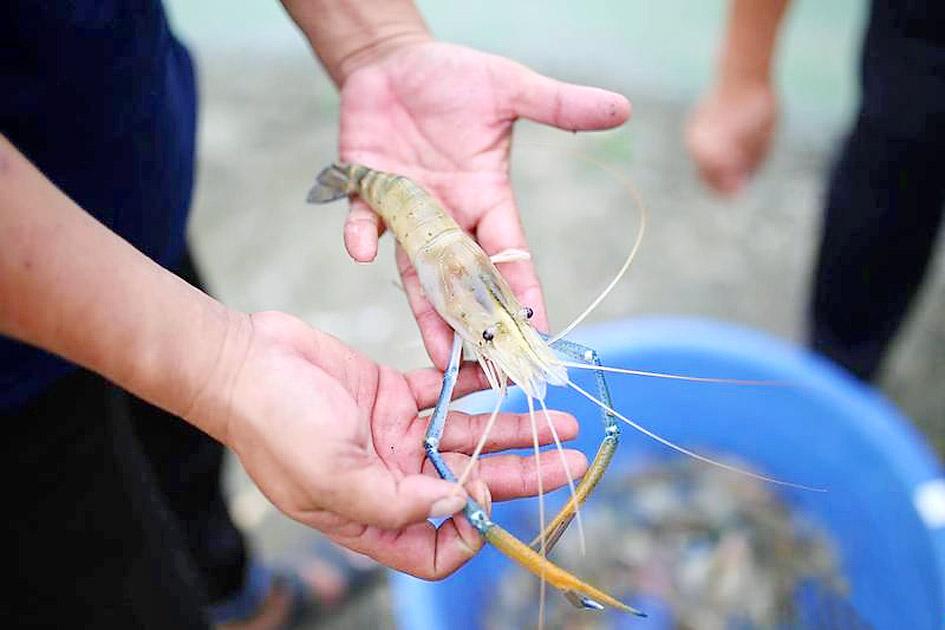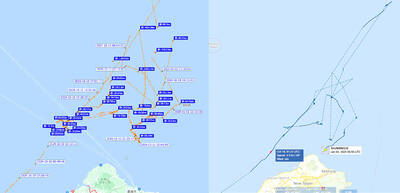Three Taiwanese entities have been approved as reference laboratories for aquatic diseases by the World Organization for Animal Health (OIE), putting them in a position to help other nations understand diseases and pandemics among aquatic species, the Bureau of Animal and Plant Health Inspection and Quarantine said last month.
Decapod iridescent virus 1 (DIV1), a pathogen that affects crustaceans and has caused enormous economic losses, has been reported in China, but while it published material that mentioned the virus, it did not notify the OIE, the bureau said.
However, Taiwan in 2020 notified the OIE — the first nation to do so — after DIV1 was found in the nation’s territorial waters, it said.

Taipei Times file photo
The virus had different mutation pathways and mortality rates among different species of shrimps, with white shrimp the most susceptible, having a mortality rate of 80 percent, National Institute for Animal Health Director Lin Yu-ju (林育如) said on Thursday last week.
The Australian red claw crayfish is mostly unaffected by DIV1, but can spread the disease, said Lin, whose institute was one of the three entities to be certified.
DIV1 has only been observed to spread among crustaceans and there is no reports of humans being affected, although crustaceans should be thoroughly cooked before being eaten, she said.
With certification as a reference lab, the institute would have more services to offer other nations, being able to provide means with which to detect DIV1, Lin said.
The lab could also provide virus specimens, allowing analysis at overseas facilities, she said.
The other two Taiwanese facilities certified as reference labs are studying white spot disease and early mortality syndrome in shrimp.
The OIE announcement shows that Taiwan’s aquatic studies are on a par with other international institutions, the bureau said.
It would continue to help Taiwanese academics apply for certification from the OIE and hopes to have more studies recognized by the international community, it said.

A strong continental cold air mass and abundant moisture bringing snow to mountains 3,000m and higher over the past few days are a reminder that more than 60 years ago Taiwan had an outdoor ski resort that gradually disappeared in part due to climate change. On Oct. 24, 2021, the National Development Council posted a series of photographs on Facebook recounting the days when Taiwan had a ski resort on Hehuanshan (合歡山) in Nantou County. More than 60 years ago, when developing a branch of the Central Cross-Island Highway, the government discovered that Hehuanshan, with an elevation of more than 3,100m,

SECURITY: To protect the nation’s Internet cables, the navy should use buoys marking waters within 50m of them as a restricted zone, a former navy squadron commander said A Chinese cargo ship repeatedly intruded into Taiwan’s contiguous and sovereign waters for three months before allegedly damaging an undersea Internet cable off Kaohsiung, a Liberty Times (sister paper of the Taipei Times) investigation revealed. Using publicly available information, the Liberty Times was able to reconstruct the Shunxing-39’s movements near Taiwan since Double Ten National Day last year. Taiwanese officials did not respond to the freighter’s intrusions until Friday last week, when the ship, registered in Cameroon and Tanzania, turned off its automatic identification system shortly before damage was inflicted to a key cable linking Taiwan to the rest of

TRANSPORT CONVENIENCE: The new ticket gates would accept a variety of mobile payment methods, and buses would be installed with QR code readers for ease of use New ticketing gates for the Taipei metro system are expected to begin service in October, allowing users to swipe with cellphones and select credit cards partnered with Taipei Rapid Transit Corp (TRTC), the company said on Tuesday. TRTC said its gates in use are experiencing difficulty due to their age, as they were first installed in 2007. Maintenance is increasingly expensive and challenging as the manufacturing of components is halted or becoming harder to find, the company said. Currently, the gates only accept EasyCard, iPass and electronic icash tickets, or one-time-use tickets purchased at kiosks, the company said. Since 2023, the company said it

China’s newest Type-076 amphibious assault ship has two strengths and weaknesses, wrote a Taiwanese defense expert, adding that further observations of its capabilities are warranted. Jiang Hsin-biao (江炘杓), an assistant researcher at the National Defense and Security Research, made the comments in a report recently published by the institute about the Chinese Communist Party’s (CCP) military and political development. China christened its new assault ship Sichuan in a ceremony on Dec. 27 last year at Shanghai’s Hudong Shipyard, China’s Xinhua news agency reported. “The vessel, described as the world’s largest amphibious assault ship by the [US think tank] Center for Strategic and International